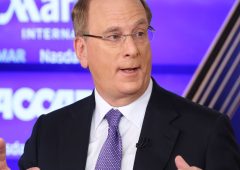No Tokenized Future Without Digital IDs, Says BlackRock CEO
13.04.2025 10:00 2 min. read Alexander Stefanov
BlackRock CEO Larry Fink is pushing a bold vision: a financial world where all assets—stocks, bonds, real estate—are digitized and exchanged via blockchain.
In his annual letter, he argued that tokenization could reshape global markets by enabling instant transfers, 24/7 trading, and faster settlement times, potentially unlocking billions in idle capital. But one critical roadblock remains: verifying identity in a digital-first, fraud-prone world.
The challenge isn’t in the technology of tokens—it’s in knowing who’s behind each transaction. Deepfakes, identity theft, and fragmented systems make it hard to trust anyone online. Without a secure and standardized way to verify digital identities, the promise of tokenized finance remains limited.
Experts say that while the tech exists—such as cryptographic verification tools and secure device-based biometrics—it’s coordination that’s lacking. National ID systems like Aadhaar in India or Estonia’s e-ID show that government-led efforts can work at scale, but they also raise concerns about privacy and centralization. Hacks in countries like El Salvador highlight the risks of storing personal data in centralized repositories.
The U.S. leans more toward decentralized solutions. Face and fingerprint recognition stored directly on users’ devices offer stronger security against mass data theft, but don’t solve the need for a unified system that can work across institutions and jurisdictions.
Efforts like mobile driver’s licenses show slow progress, and industry players remain divided on how to move forward—especially with private vendors wary of a government standard that could edge them out.
Fink has been vocal at events like Davos, urging regulators to embrace tokenization—not just to modernize markets, but to reduce overheads for firms like BlackRock, which face mounting costs tied to proxy voting and compliance.
Ultimately, Fink’s message is that tokenizing assets isn’t enough. For the future he envisions to work, the financial industry needs a secure, trusted identity layer. Until then, blockchain’s full potential will remain just out of reach.
-
1
PancakeSwap Unveils Seamless Crosschain Swaps with Game-Changing Upgrade
12.06.2025 13:00 1 min. read -
2
Israel vs. Iran: Who Really Leads the Middle-East Blockchain Race?
13.06.2025 20:00 2 min. read -
3
XRP Ledger Deploys EVM-Compatible Sidechain to Expand Multichain Utility
30.06.2025 21:00 2 min. read -
4
Solana Partners with Kazakhstan to Launch Digital Economy Zone
22.06.2025 18:00 2 min. read -
5
Binance Prepares for THORChain Upgrade, Temporarily Halts RUNE Transfers
17.06.2025 16:55 1 min. read
XRP Ledger Deploys EVM-Compatible Sidechain to Expand Multichain Utility
The XRP Ledger (XRPL) has officially launched its Ethereum Virtual Machine (EVM) sidechain on mainnet — marking a major milestone in its effort to bridge XRP’s payment efficiency with Ethereum’s smart contract capabilities.
What the U.S. Blockchain Act Means for Crypto’s Future
The U.S. House of Representatives has taken a major step toward digital asset regulation by passing the Deploying American Blockchains Act of 2025.
Top 10 DeFi Projects by Development This Month
According to a new report by Santiment, Chainlink ($LINK) has maintained its dominant position as the most actively developed DeFi project over the past 30 days.
XRP Ledger Sees Sharp Drop in Activity as Key Network Metrics Tumble
The XRP Ledger has seen a dramatic slowdown in usage, with fresh data revealing a steep drop in both transactions and new account activations—raising concerns about the token’s short-term outlook.
-
1
PancakeSwap Unveils Seamless Crosschain Swaps with Game-Changing Upgrade
12.06.2025 13:00 1 min. read -
2
Israel vs. Iran: Who Really Leads the Middle-East Blockchain Race?
13.06.2025 20:00 2 min. read -
3
XRP Ledger Deploys EVM-Compatible Sidechain to Expand Multichain Utility
30.06.2025 21:00 2 min. read -
4
Solana Partners with Kazakhstan to Launch Digital Economy Zone
22.06.2025 18:00 2 min. read -
5
Binance Prepares for THORChain Upgrade, Temporarily Halts RUNE Transfers
17.06.2025 16:55 1 min. read


